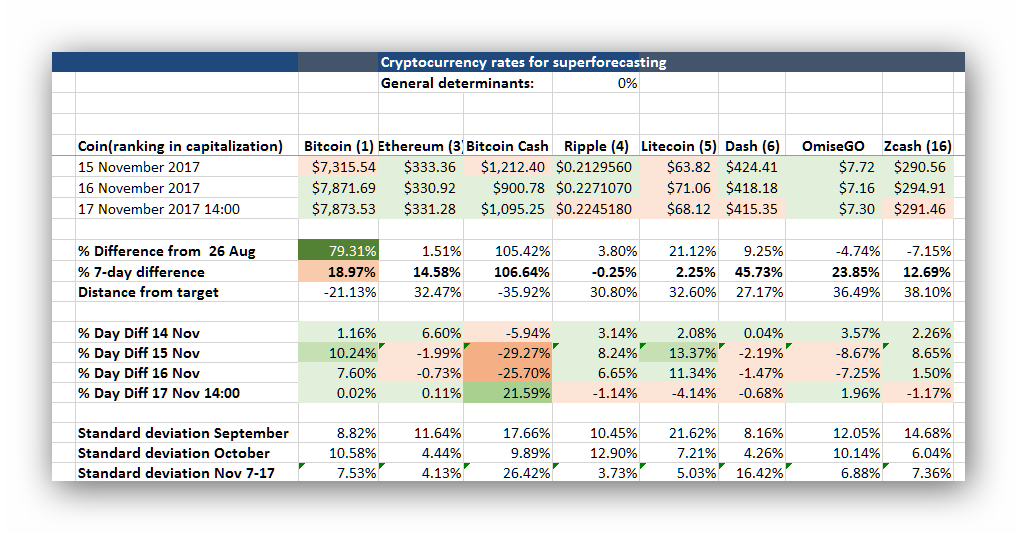Superforecasting cryptocurrencies: Week 10: Whatever
17 November 2017
Looking backward, looking forward

Two weeks from 1 December and all e-tokens except Bitcoin Core (BTC) and Bitcoin Cash (BCH) are way off the 50% target I set on 26 August. It strikes me as clear that the deadline I set is not the deadline that investors and traders have put on prices.
The gold and dollar factor
And why should they? Many investors seem to be holding bitcoins and altcoins for their long-term value rather than quick profits.
The e-coin marketplace continues to grow ($128 bn at the moment, more than Malaysia's GDP or all but the biggest companies). Extreme variability has not frightened away the punters: the growing weakness of the dollar and decline in gold prices may have helped among those who traditionally relied on these refuges to stash their savings. In places like Zimbabwe you can't get hold of US$, for example, and gold can make you a target for thieves.
The strange case of ethereum
Ethereum, the most likely long-term competitor for bitcoin, is only 1.5% more in price than on 26 August. OmiseGO, aimed at the Asian market, and Zcash, with its emphasis on privacy, are both below the starting price.
In terms of volatility, in October and November, ethereum recorded a respectable 4%. Good for long-term investors, but its 7-day change in price was nearly 15%. And despite having a market cap of 25% of the bitcoin total, its $334 price is 5% of bitcoin's $7,810. Whatever.
The volatility question
Conventional advice to investors in the stock market is to balance your investments against the volatility of the stock. That is, invest more in a less volatile stock and vice-versa. You can calculate this mathematically (it's easy with a spreadsheet or calculator) to even out the risks your investments run.
For example, if you have $1000 to invest and the stock price is $10, you would normally buy 100 units. But what if the volatility is 50% (that is, its price has varied by 50% over the period you are considering, say the past month). Then you would price the stock at $15 and only buy some 60 units. For another stock with a volatility of 2%, you would buy some 80 units. The risk you run would therefore be the same.
Why cryptocoins are different
These rules don't seem to make sense for cryptocurrencies. The volatility, measured by the standard deviation in closing prices, show that Bitcoin Cash (BCH) since 1 November has been 26.42%. Does that mean you should be buying proportionately fewer e-tokens? I don't think so.
To me, it's another example of how e-coins differ from stocks. They are crowdfunding projects rather than investments, no matter that some traders want to treat them this way. It means that putting more cash into the project is likely to help it get off the ground, rather than simply give another trader a chance to rip you off by selling the holdings so that the price goes down.
Background to the tokens followed
I've profiled the seven tokens I am tracking here.
I've also profiled other less popular tokens.
Excel version
Click here for an Excel 1997-2003 version of this table with records key records, free for download.
There's also an Excel version of the shorter summary screenshot used above.